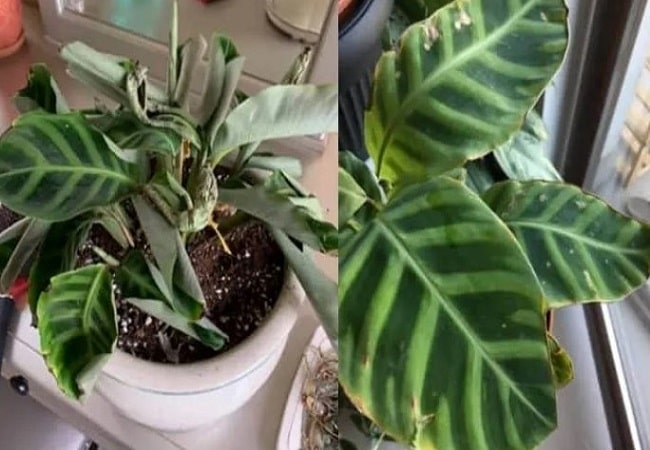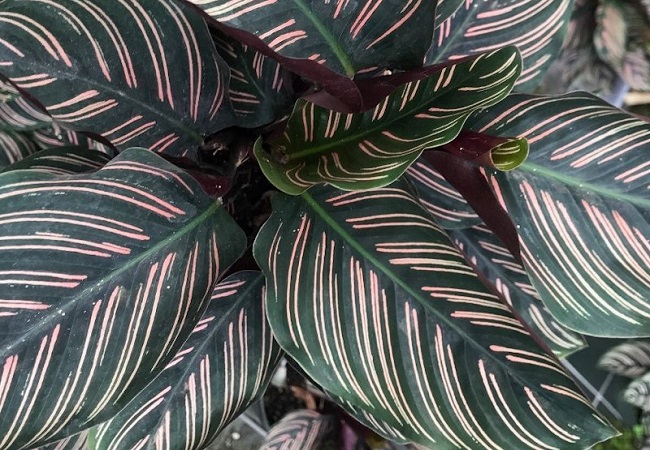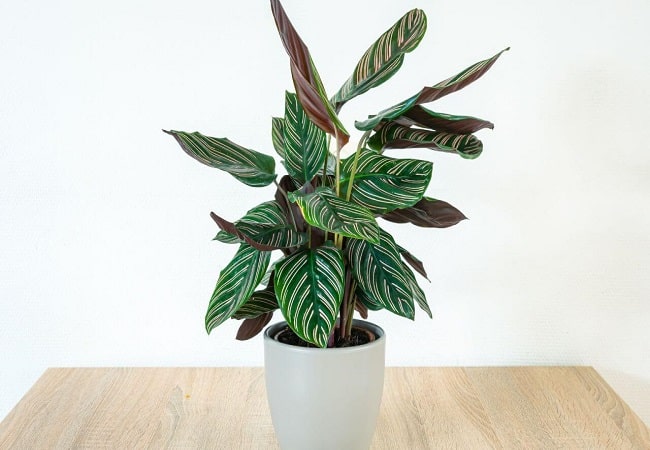Last Updated on April 26, 2023 by Md Deloar Hossain
Calathea leaves look great in any room or office. But how to uncurl calathea leaves the leaves can curl up sometimes. Curling leaves are caused by low humidity, too much sun, or even pests.
Calathea houseplants often have trouble with leaf curls. It is scary, but with some knowledge and some TLC for the plant, You can usually fix it quickly and easily. Most of the time, it’s easy to take care of these beautiful houseplants, but their owners still need to know their likes and dislikes.
You’re lucky if you want to know how to get calathea leaves out of their curls. In this blog post, I will show you how to uncurl the leaves of calathea. Keep reading to find out more!
Quick Navigation
The Problem: Why Calathea Leaves Curl?

Calathea leaves curl for a few different reasons. Most of the time, it’s because there is too much or insufficient water. If the plant isn’t getting enough water, the leaves will curl up to keep what little water they have. If the plant gets too much water, on the other hand, the leaves will curl to keep the plant from rotting. Temperature stress is another thing that could cause leaves to curl. If the plant is in a draft or the temperature changes quickly, the leaves may curl as a response. Here is the most common reason:
Too Much Direct Sunlight
Calatheas do best in a bright room that doesn’t get direct sunlight. Too much direct sunlight will burn your plant’s beautiful leaves, making them turn brown at the tips, fade, or feel crispy.
In tropical rainforests, you can find wild Calathea plants growing under the trees. These plants do best in shady, low-light spots like the cool undergrowth where they live in the wild.
If your Calathea plant is in direct sunlight, the leaves will turn yellow, and the white and green markings may even disappear. Calathea plants often curl their leaves to try to get less light. If you put your plant back in the shade, the leaves should open up in a day or two.
Low Humidity
Calatheas like high humidity. Low humidity is a significant cause of calathea leaf curling.
Calathea plants prefer humidity exceeding 50%. Calathea plant care varies by type. Calathea Medallion grows better at lower humidity than Fusion White, which needs 80% or higher. Because terrariums and other enclosures are easy to keep humid, they may aid finicky plants.
For delicate plants, calathea leaves may dry up or have brown tips if the air humidity is less than 50%, a possible first sign. Not all leaves turn brown. When leaves of calathea get wet, they curl instead of dying. Even though the humidity is low, the plant should be healthy.
Improper Watering
The main reason calathea leaves curl is because they don’t get enough water. Some calathea plants are showier than others, and their leaves will curl up when the soil is just a little bit too dry.
If the top layer of the soil is dry, check the soil and water your plant. Only let half an inch of the soil get wet. Calatheas do best in soil that stays moist primarily.
If you don’t water your calathea enough, the leaves will likely turn brown and curl up.
If you give your plant too much water, the leaves may curl. However, you are more likely to see other signs, like yellowing calathea leaves and the plant wilting. If you water your plants too often and don’t let the top inch of soil dry out, you probably water them too often. If you notice that the top layer of dirt on your plant is still wet days after you watered it. You are overwatering. If your pot doesn’t have holes for water to drain, it’s easy to give your plant too much water. The same is true if you put a jar inside a decorative jar and water pools at the bottom.
Too much water will hurt the roots and could even cause root rot. Roots that are damaged can’t do their job, and root rot can kill your calathea plant.
Extreme Or Changing Temperatures
Stay away from temperatures that are too low or too high. Both of these can make the leaves of your calathea curl. Since these plants do well in average room temperatures, likely, the conditions in your home are already promising.
You need to pay attention to temperature changes that can happen quickly and dramatically in drafts, which is unsuitable for your calathea. These things can cause their leaves to curl, which makes the plant look bad.
The Solution: How To Uncurl Calathea Leaves?

The leaves of calathea plants like to move around. A healthy Calathea will turn its leaves slowly to catch the sun. A sick Calathea will curl its leaves tightly to show it is in trouble. Once the problem is fixed, the leaves might even straighten out right in front of your eyes. Here are a few ways to uncurl calathea leaves:
The Way To Fix Calathea Leaves Curling

To fix the curling leaves, you need to raise the humidity around the plant. Here are some ideas on how to do that:
- Often spray the plant. Fill a spray bottle with lukewarm water, turn it to “mist,” and spray the air around the plant’s leaves several times a day.
- Use a tray for rocks. Fill a shallow tray halfway with pebbles, and then fill the tray with water. Make sure the bottom of the pot doesn’t touch the water when you put the plant on the pebbles. A humidity tray is a name for it.
- Put it close to a humidifier. Put your plant in the same room as a good houseplant humidifier. If you live in a dry area or if the air is very dry in the winter, put your plant in the same room as a good humidifier for houseplants.
Those are the best ways to make it more humid around your Calathea, which is why the leaves are curling. Also, ensure you keep the plant from a wood stove or heating vent where it will get blasted with warm air.
The Way To Preventing Curling Leaves
Think about the following ways to keep your calathea leaves from curling in the future. Follow these instructions to take care of the plant to keep it healthy and happy.
You Should Wash Your Plant
You should wash your plant. It may sound strange, but calathea grows better when it gets a light rain every so often. This cleans the leaves and makes the air moister. I put my calathea in the bathtub and gently spray the leaves with lukewarm water from the sprayer nozzle. Let it drain for an hour or two before putting it back where it belongs.
Clean The Leaf Surfaces
Get the leaves clean. Unfortunately, many people just starting with indoor gardening tend to forget about this. To keep leaves in good shape, wipe them down regularly with a damp, soft cloth to eliminate dust, hair, and other debris.
Change Your Watering Practices
Change the way you water. The soil around your Calathea should always be moist but never sit in water. Keep a close eye on how you water to find the right balance. Calathea likes soil that is neither too wet nor too dry. It would help if you never let the soil dry out. If the top of the ground feels dry, you should water your plant immediately. Calathea is a plant that grows in the tropics and always needs a lot of water and humidity. A typical home will need to be watered several times a week.
Keep The Temperature At The Correct Level
Change the room’s temperature. Calatheas do best in temperatures between 60 and 85°F (16 and 29°C). Check where your Calathea sits, not just the room’s temperature.
Keep the temperature between 60°F and 85°F (16°C and 29°C). All kinds of calathea will grow well in these conditions. However, some may be able to handle temperatures that are a little higher or lower. Don’t let the temperature drop below 60° Fahrenheit (15°C).
Suggestions For Calathea’s Continued Good Health
They even have a light around a problem. Calathea should never be put in direct sunlight. This can cause the leaves to dry and curl or turn brown.
- This plant grows best in bright, indirect sunlight. It is native to the jungle floor, where it likes to be damp, calm, and in the shade.
- The best window is one that faces north or east. You can also put the plant three to five feet away from a bright window or use sheer curtains to soften the light.
- Lastly, make sure you know what to do before you start caring.
Check out our other articles on Calathea plants,
Most Commonly Asked Questions
Can I Give My Calathea Tap Water?
If you want to give your calathea tap water, you can, but let it sit out for a day or two, so the chlorine can evaporate. Bottled water is always best, but tap water will do if you’re in a pinch.
Can Curled Calathea Leaves Recover?
There are a few things that you can do to help your curled Calathea leaves recover.
- First, you will want to ensure that you water your plant regularly and evenly.
- Secondly, you can increase the humidity around your plant by misting it or placing it on a pebble tray.
- Lastly, consider fertilising your plant with a balanced fertiliser. If you follow these steps, your Calathea should start to recover soon.
How Long Does It Take For Calathea To Uncurl?
The average Calathea will take anywhere from 12-24 hours to uncurl. This process is typically faster in lower-humidity environments and slower in higher-humidity environments. If the plant is wilted, it may take longer for the leaves to uncurl.
Should I Cut Off Damaged Calathea Leaves?
If your Calathea leaves are damaged, you may wonder if you should cut them off. The answer depends on the damage’s extent and the plant’s overall health. If the leaves are only lightly damaged, you can trim off the damaged parts. However, if the leaves are severely damaged or your plant is already unhealthy, remove them altogether. This will help your plant focus its energy on new growth and prevent further damage.
Why Is My Calathea Not Closing?
There are a few reasons why your Calathea might still need to close. One reason could be that the plant isn’t getting enough light. Calatheas need bright, indirect light to thrive, so if your plant is too shady, it won’t get the light it needs to close up at night. Another reason could be that the plant is too dry.
Final Touch
You can get calathea leaves to stop curling by misting them with water, making the air around the plant more humid, or gently wrapping the leaves around a pencil. Regardless of your chosen method, keep an eye on your plant and make changes as needed until the leaves return to normal.

I’m Md. Mahfuz Anam always enjoys taking care of plants and gardening. I find it therapeutic and a great way to relax. I have also always been interested in learning about different types of plants and how to care for them.


